Embedded Piezo-Sensor-Based Automatic Performance Monitoring of Chloride-Induced Corrosion in Alkali-Activated Concrete
Abstract
:1. Introduction
2. Materials and Methods
2.1. Materials and Concrete Specimens
2.2. Accelerated Corrosion Test
2.3. EMI Technique
2.4. Data Acquisition
2.5. Statistical Indices
2.6. Extraction of Equivalent Structural Parameters
3. Results and Discussion
3.1. Analysis Based on EMI Signature
3.2. Analysis Based on Statistical Indices
3.3. Analysis Based on Equivalent Structural Parameters
4. Conclusions
Author Contributions
Funding
Institutional Review Board Statement
Informed Consent Statement
Data Availability Statement
Conflicts of Interest
References
- United Nations Environment Programme. 2021 Global Status Report for Buildings and Construction: Towards a Zero-Emission, Efficient and Resilient Buildings and Construction Sector; United Nations: New York, NY, USA, 2021. [Google Scholar]
- Prakash, R.; Divyah, N.; Srividhya, S.; Avudaiappan, S.; Amran, M.; Naidu Raman, S.; Guindos, P.; Vatin, N.I.; Fediuk, R. Effect of Steel Fiber on the Strength and Flexural Characteristics of Coconut Shell Concrete Partially Blended with Fly Ash. Materials 2022, 15, 4272. [Google Scholar] [CrossRef] [PubMed]
- Prakash, R.; Raman, S.N.; Subramanian, C.; Divyah, N. Eco-Friendly Fiber-Reinforced Concretes. In Handbook of Sustainable Concrete and Industrial Waste Management: Recycled and Artificial Aggregate, Innovative Eco-friendly Binders, and Life Cycle Assessment; Woodhead Publishing: Sawston, UK, 2022; pp. 109–145. [Google Scholar] [CrossRef]
- Scrivener, K.; Martirena, F.; Bishnoi, S.; Maity, S. Calcined Clay Limestone Cements (LC3). Cem. Concr. Res. 2018, 114, 49–56. [Google Scholar] [CrossRef]
- El-Hassan, H.; Elkholy, S. Enhancing the Performance of Alkali-Activated Slag-Fly Ash Blended Concrete through Hybrid Steel Fiber Reinforcement. Constr. Build. Mater. 2021, 311, 125313. [Google Scholar] [CrossRef]
- Beersaerts, G.; Ascensão, G.; Pontikes, Y. Modifying the Pore Size Distribution in Fe-Rich Inorganic Polymer Mortars: An Effective Shrinkage Mitigation Strategy. Cem. Concr. Res. 2021, 141, 106330. [Google Scholar] [CrossRef]
- Ascensão, G.; Marchi, M.; Segata, M.; Faleschini, F.; Pontikes, Y. Reaction Kinetics and Structural Analysis of Alkali Activated Fe–Si–Ca Rich Materials. J. Clean. Prod. 2020, 246, 119065. [Google Scholar] [CrossRef]
- Singaram, K.K.; Khan, M.A.; Talakokula, V. Statistical Analysis of Fly Ash and Slag Blended Geopolymer Concrete. Mater. Today Proc. 2022, 61, 466–476. [Google Scholar] [CrossRef]
- Qin, L.; Gao, X.; Zhang, A. Potential Application of Portland Cement-Calcium Sulfoaluminate Cement Blends to Avoid Early Age Frost Damage. Constr. Build. Mater. 2018, 190, 363–372. [Google Scholar] [CrossRef]
- Ascensão, G.; Faleschini, F.; Marchi, M.; Segata, M.; van de Sande, J.; Rahier, H.; Bernardo, E.; Pontikes, Y. High-Temperature Behavior of CaO-FeOx-Al2 O3-SiO2-Rich Alkali Activated Materials. Appl. Sci. 2022, 12, 2572. [Google Scholar] [CrossRef]
- Bernal, S.A.; Mejía De Gutiérrez, R.; Pedraza, A.L.; Provis, J.L.; Rodriguez, E.D.; Delvasto, S. Effect of Binder Content on the Performance of Alkali-Activated Slag Concretes. Cem. Concr. Res. 2011, 41, 105786. [Google Scholar] [CrossRef]
- Topolář, L.; Šimonová, H.; Rovnaník, P.; Schmid, P. The Effect of the Carbon Nanotubes on the Mechanical Fracture Properties of Alkali Activated Slag Mortars. In Proceedings of the Applied Mechanics and Materials; Trans Tech Publications Ltd.: Bach, Switzerland, 2014; Volume 617, pp. 243–246. [Google Scholar]
- Mithun, B.M.; Narasimhan, M.C. Performance of Alkali Activated Slag Concrete Mixes Incorporating Copper Slag as Fine Aggregate. J. Clean. Prod. 2016, 112, 837–844. [Google Scholar] [CrossRef]
- Cao, R.; Zhang, S.; Banthia, N.; Zhang, Y.; Zhang, Z. Interpreting the Early-Age Reaction Process of Alkali-Activated Slag by Using Combined Embedded Ultrasonic Measurement, Thermal Analysis, XRD, FTIR and SEM. Compos. B Eng. 2020, 186, 107840. [Google Scholar] [CrossRef]
- Shi, J.; Ming, J.; Sun, W. Electrochemical Performance of Reinforcing Steel in Alkali-Activated Slag Extract in the Presence of Chlorides. Corros. Sci. 2018, 133, 288–299. [Google Scholar] [CrossRef]
- Ma, Q.; Nanukuttan, S.V.; Basheer, P.A.M.; Bai, Y.; Yang, C. Chloride Transport and the Resulting Corrosion of Steel Bars in Alkali Activated Slag Concretes. Mater. Struct. Mater. Constr. 2016, 49, 3663–3677. [Google Scholar] [CrossRef] [Green Version]
- Shi, J.; Wu, M.; Ming, J. Long-Term Corrosion Resistance of Reinforcing Steel in Alkali-Activated Slag Mortar after Exposure to Marine Environments. Corros. Sci. 2021, 179, 109175. [Google Scholar] [CrossRef]
- Sadowski, L. Methodology for Assessing the Probability of Corrosion in Concrete Structures on the Basis of Half-Cell Potential and Concrete Resistivity Measurements. Sci. World J. 2013, 2013, 714501. [Google Scholar] [CrossRef] [Green Version]
- Wu, Z.; Yu, H.; Ma, H.; Zhang, J.; Da, B.; Zhu, H. Rebar Corrosion in Coral Aggregate Concrete: Determination of Chloride Threshold by LPR. Corros. Sci. 2020, 163, 108238. [Google Scholar] [CrossRef]
- Montemor, M.F.; Sim, A.M.P.; Salta, M.M. Effect of Fly Ash on Concrete Reinforcement Corrosion Studied by EIS. Chem. Eng. 2000, 22, 175–185. [Google Scholar] [CrossRef]
- Bansal, T.; Talakokula, V. Deterioration of Structural Parameters Due to Corrosion in Prestressed Concrete Identified by Smart Probe-Based Piezo Sensor. Eng. Res. Express 2021, 3, 015011. [Google Scholar] [CrossRef]
- Bansal, T.; Talakokula, V.; Sathujoda, P. A Machine Learning Approach for Predicting the Electro-Mechanical Impedance Data of Blended RC Structures Subjected to Chloride Laden Environment. Smart Mater. Struct. 2022, 31, 015036. [Google Scholar] [CrossRef]
- Bansal, T.; Talakokula, V.; Bhalla, S. Model Based Corrosion Assessment in Rebars of Different Fly Ash Blended Concrete Using Piezo Sensors. In Proceedings of the 7th Asia-Pacific Workshop on Structural Health Monitoring, APWSHM 2018, Hong Kong, China, 12–15 November 2018; pp. 902–913. [Google Scholar]
- Bansal, T.; Talakokula, V. Study of Durability Aspects of Limestone Calcined Clay Cement Using Different Piezo Configurations. In RILEM Bookseries; Springer: Singapore, 2020; Volume 25, pp. 723–730. [Google Scholar]
- Raju, J.; Bhalla, S.; Talakokula, V.; Thakur, S. Industrial Applications of Electro-Mechanical Impedance Technique in Novel Non-Bonded Configurations. In Sensors and Smart Structures Technologies for Civil, Mechanical, and Aerospace Systems; SPIE: Bellingham, DC, USA, 2019; Volume 10970, pp. 44–50. [Google Scholar] [CrossRef]
- Bansal, T.; Talakokula, V.; Mathiyazhagan, K. Equivalent Structural Parameters Based Non-Destructive Prediction of Sustainable Concrete Strength Using Machine Learning Models Via Piezo Sensor. Measurement 2021, 187, 110202. [Google Scholar] [CrossRef]
- Bansal, T.; Talakokula, V. Monitoring Strength Development of Cement Substituted by Limestone Calcined Clay Using Different Piezo Configurations. In RILEM Bookseries; Springer: Singapore, 2020; Volume 25, pp. 555–562. [Google Scholar]
- Negi, P.; Chhabra, R.; Kaur, N.; Bhalla, S. Health Monitoring of Reinforced Concrete Structures under Impact Using Multiple Piezo-Based Configurations. Constr. Build. Mater. 2019, 222, 371–389. [Google Scholar] [CrossRef]
- Nguyen, T.C.; Huynh, T.C.; Yi, J.H.; Kim, J.T. Hybrid Bolt-Loosening Detection in Wind Turbine Tower Structures by Vibration and Impedance Responses. Wind. Struct. Int. J. 2017, 24, 385–403. [Google Scholar] [CrossRef]
- Talakokula, V.; Bhalla, S.; Gupta, A. Corrosion Assessment of Reinforced Concrete Structures Based on Equivalent Structural Parameters Using Electro-Mechanical Impedance Technique. J. Intell. Mater. Syst. Struct. 2014, 25, 484–500. [Google Scholar] [CrossRef]
- Talakokula, V.; Bhalla, S.; Ball, R.J.; Bowen, C.R.; Pesce, G.L.; Kurchania, R.; Bhattacharjee, B.; Gupta, A.; Paine, K. Diagnosis of Carbonation Induced Corrosion Initiation and Progression in Reinforced Concrete Structures Using Piezo-Impedance Transducers. Sens. Actuators A Phys. 2016, 242, 79–91. [Google Scholar] [CrossRef] [Green Version]
- Talakokula, V.; Bhalla, S. Reinforcement Corrosion Assessment Capability of Surface Bonded and Embedded Piezo Sensors for Reinforced Concrete Structures. J. Intell. Mater. Syst. Struct. 2015, 26, 2304–2313. [Google Scholar] [CrossRef]
- Sriramadasu, R.C.; Lu, Y.; Banerjee, S. Identification of Incipient Pitting Corrosion in Reinforced Concrete Structures Using Guided Waves and Piezoelectric Wafer Transducers. Struct. Health Monit. 2019, 18, 164–171. [Google Scholar] [CrossRef]
- Huo, L.; Li, C.; Jiang, T.; Li, H.N. Feasibility Study of Steel Bar Corrosion Monitoring Using a Piezoceramic Transducer Enabled Time Reversal Method. Appl. Sci. 2018, 8, 2304. [Google Scholar] [CrossRef] [Green Version]
- Bansal, T.; Talakokula, V.; Sathujoda, P. Durability Aspects of Blended Concrete Systems Subjected to Combined Mechanical and Environmental Loading Using Piezo Sensor. Constr. Build. Mater. 2022, 348, 128613. [Google Scholar] [CrossRef]
- BIS 1786; High Strength Deformed Steel Bars and Wires for Concrete Reinforcement. Bureau of Indian Standards: New Delhi, India, 2008.
- BIS 2386–3; Methods of Test for Aggregates for Concrete, Part. 3: Specific Gravity, Density, Voids, Absorption and Bulking. Bureau of Indian Standards: New Delhi, India, 1963.
- BIS 10262–2009; Indian Concrete Mix Design Guidelines. Bureau of Indian Standards: New Delhi, India, 2009.
- Ramachandran, A.; Anuradha, R.; Sreevidya, V.; Venkatasubramani, R.; Rangan, B. Modified Guidelines for Geopolymer Concrete Mix Design Using Indian Standaard. Asian J. Civ. Eng. Build. Hous. 2012, 13, 353–364. [Google Scholar]
- Bhalla, S.; Soh, C.K. Structural Health Monitoring by Piezo-Impedance Transducers. I: Modeling. J. Aerosp. Eng. 2004, 17, 154–165. [Google Scholar] [CrossRef]
- Bharathi Priya, C.; Jothi Saravanan, T.; Balamonica, K.; Gopalakrishnan, N.; Rao, A.R.M. EMI Based Monitoring of Early-Age Characteristics of Concrete and Comparison of Serial/Parallel Multi-Sensing Technique. Constr. Build. Mater. 2018, 191, 1268–1284. [Google Scholar] [CrossRef]
- Bhalla, S.; Vittal, P.A.; Veljkovic, M. Piezo-Impedance Transducers for Residual Fatigue Life Assessment of Bolted Steel Joints. Struct. Health Monit. 2012, 11, 733–750. [Google Scholar] [CrossRef]
- Soh, C.K.; Bhalla, S. Calibration of Piezo-Impedance Transducers for Strength Prediction and Damage Assessment of Concrete. Smart Mater. Struct. 2005, 14, 671–684. [Google Scholar] [CrossRef] [Green Version]
- Talakokula, V.; Bhalla, S.; Gupta, A. Monitoring Early Hydration of Reinforced Concrete Structures Using Structural Parameters Identified by Piezo Sensors via Electromechanical Impedance Technique. Mech. Syst. Signal Process. 2018, 99, 129–141. [Google Scholar] [CrossRef]
- Moharana, S.; Bhalla, S. Development and Evaluation of an External Reusable Piezo-Based Concrete Hydration-Monitoring Sensor. J. Intell. Mater. Syst. Struct. 2019, 30, 2770–2788. [Google Scholar] [CrossRef]
- Hixon, E.L. Mechanical Impedance Shock and Vibration Handbook, 3rd ed.; Harris, C.M., Ed.; Mc Graw Hill Book Co: New York, NY, USA, 1998. [Google Scholar]

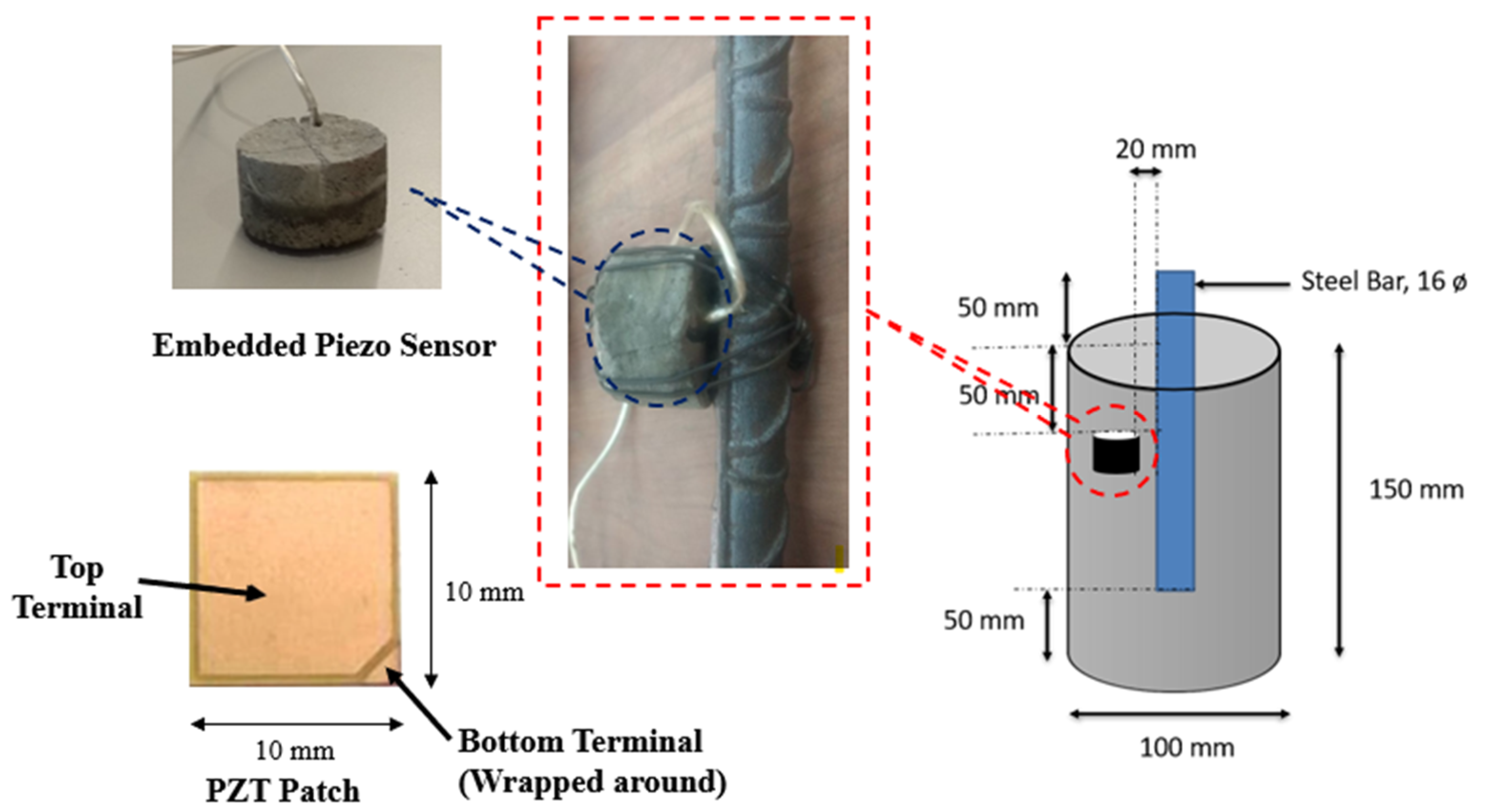


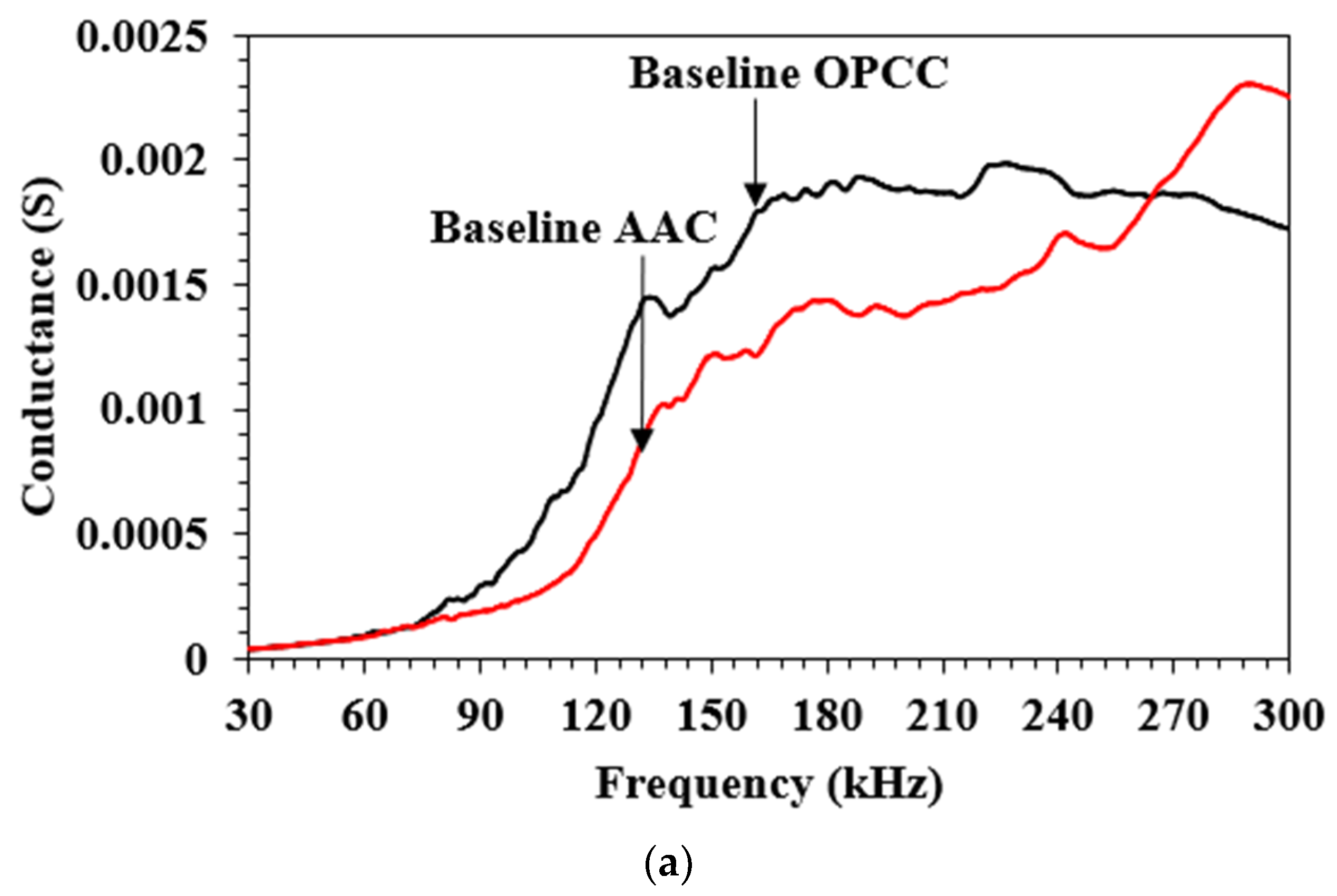
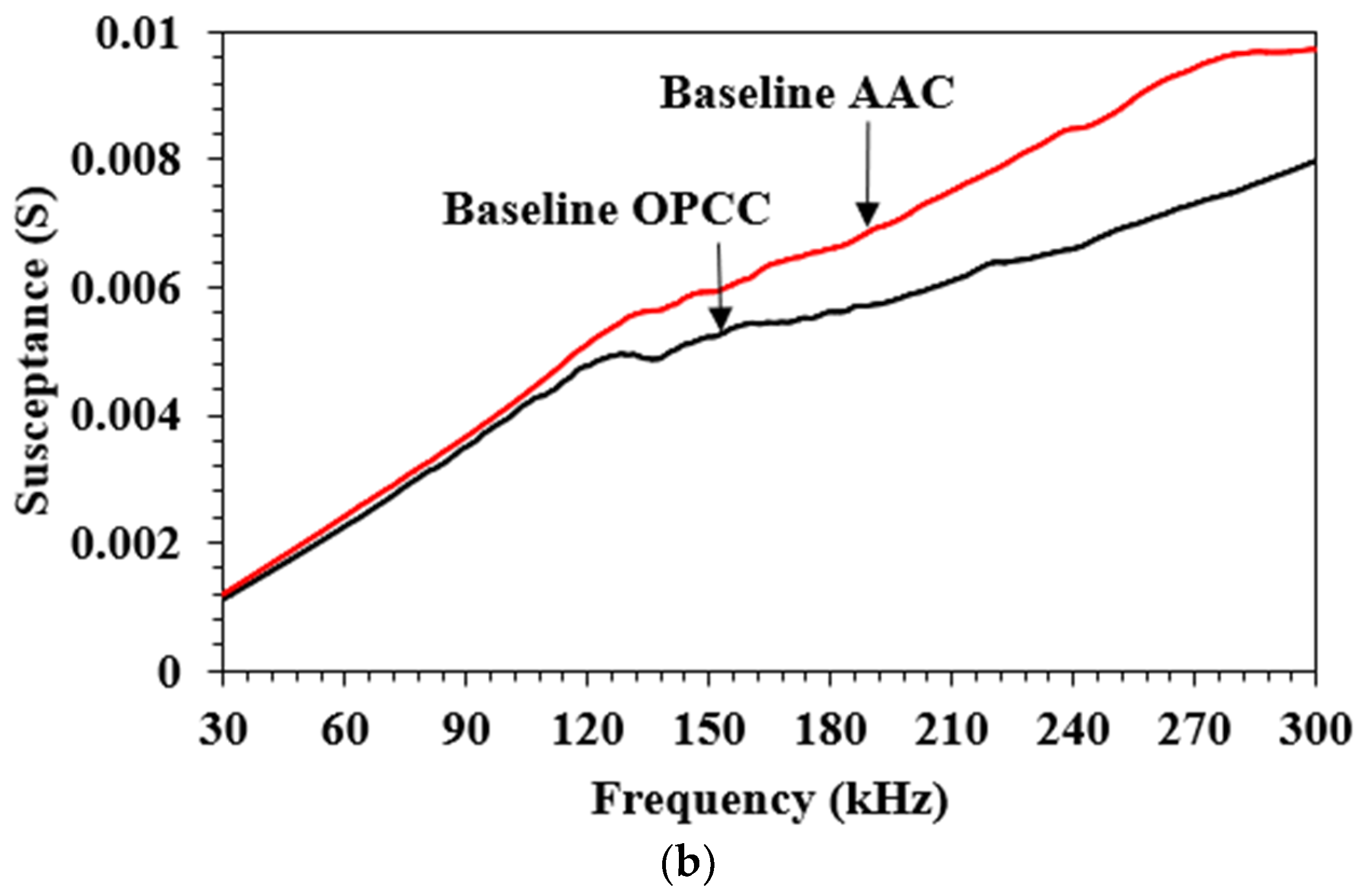

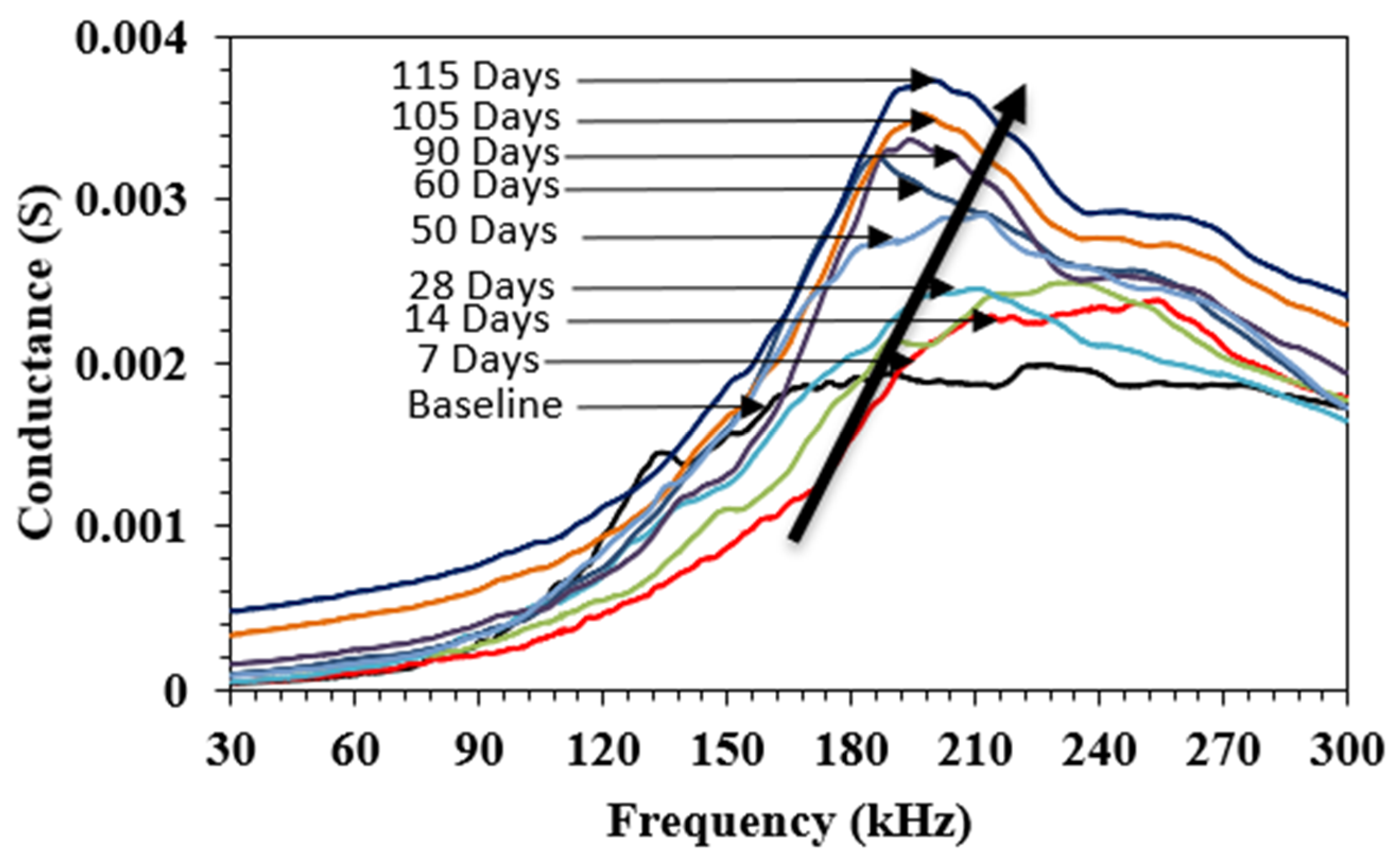
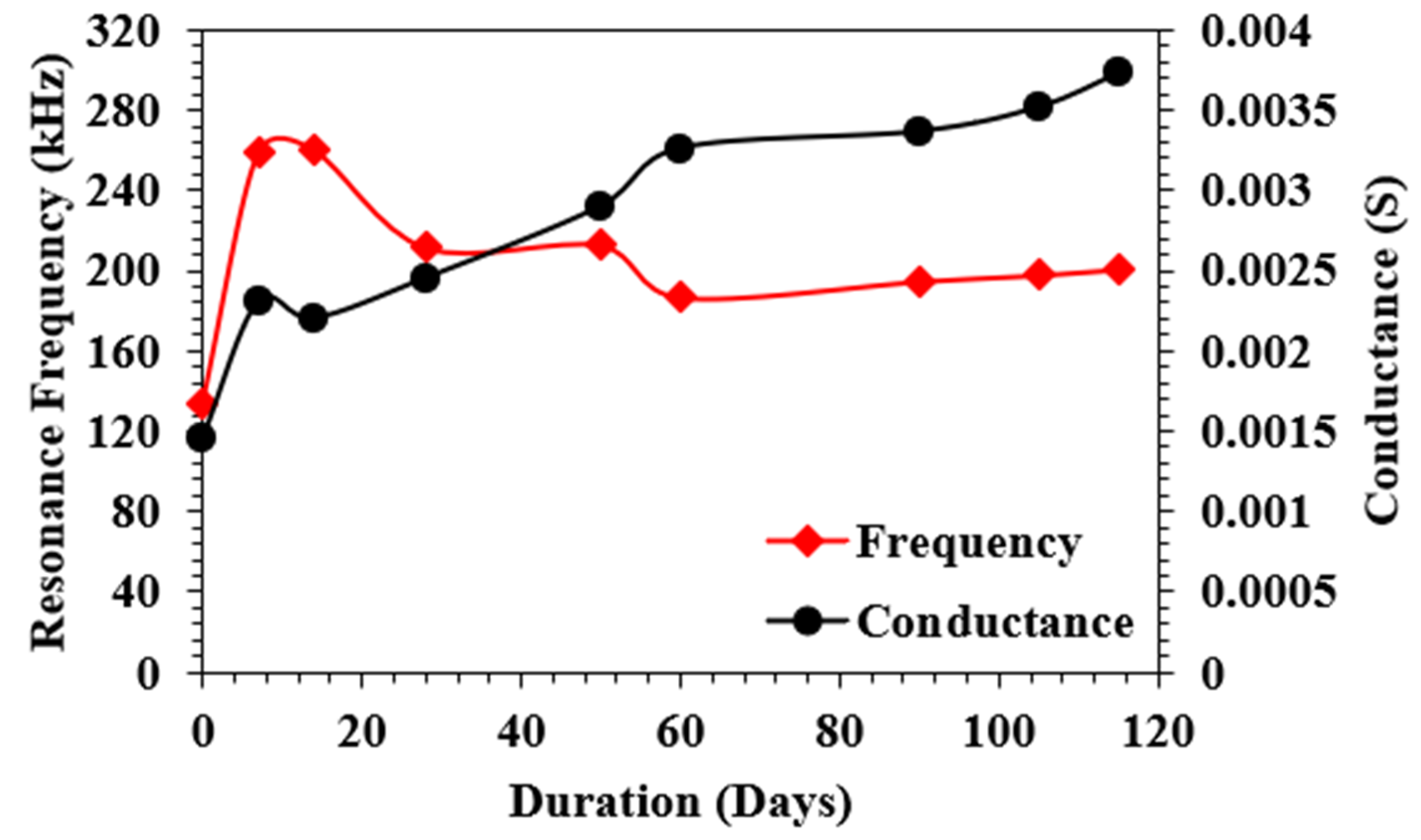

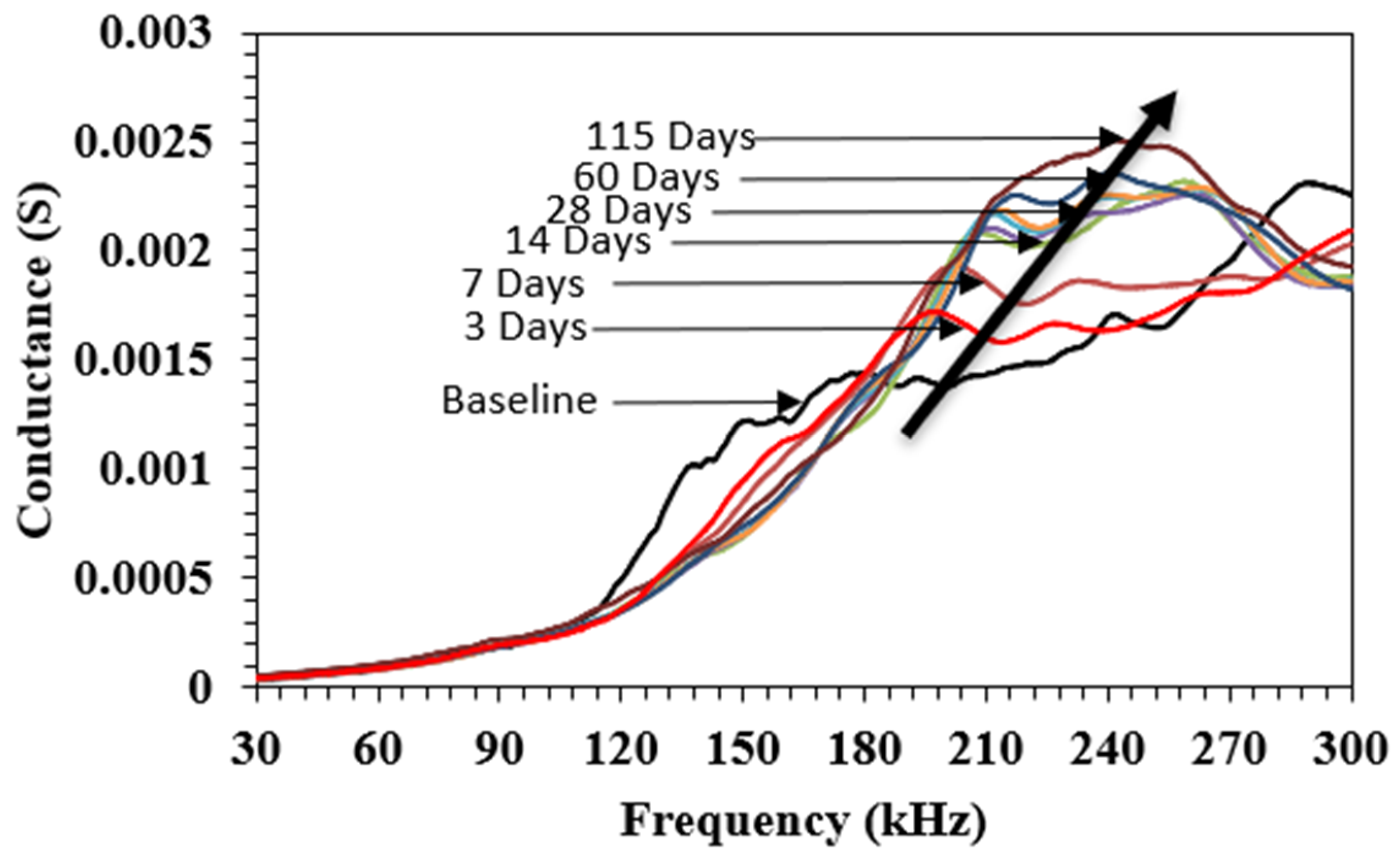
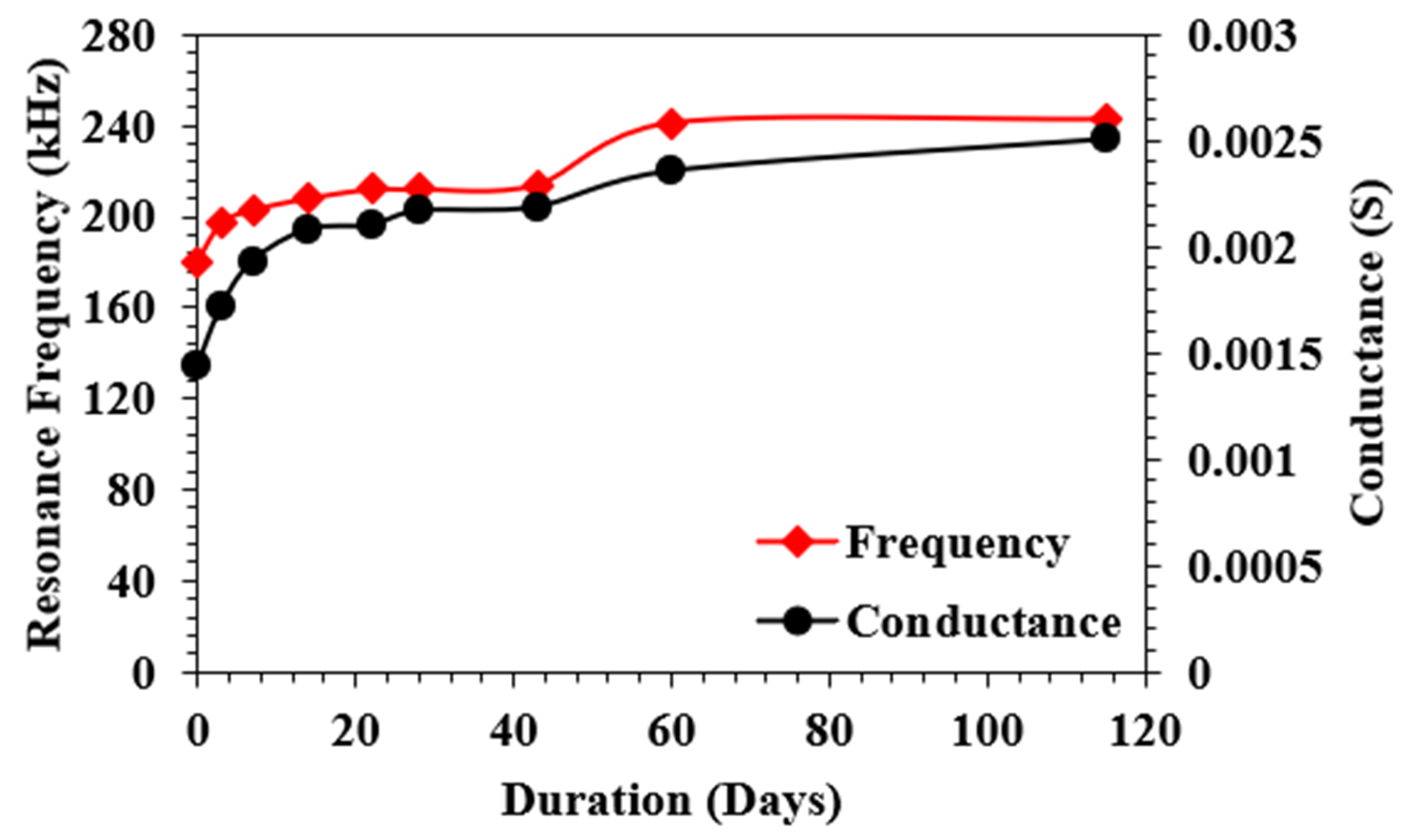

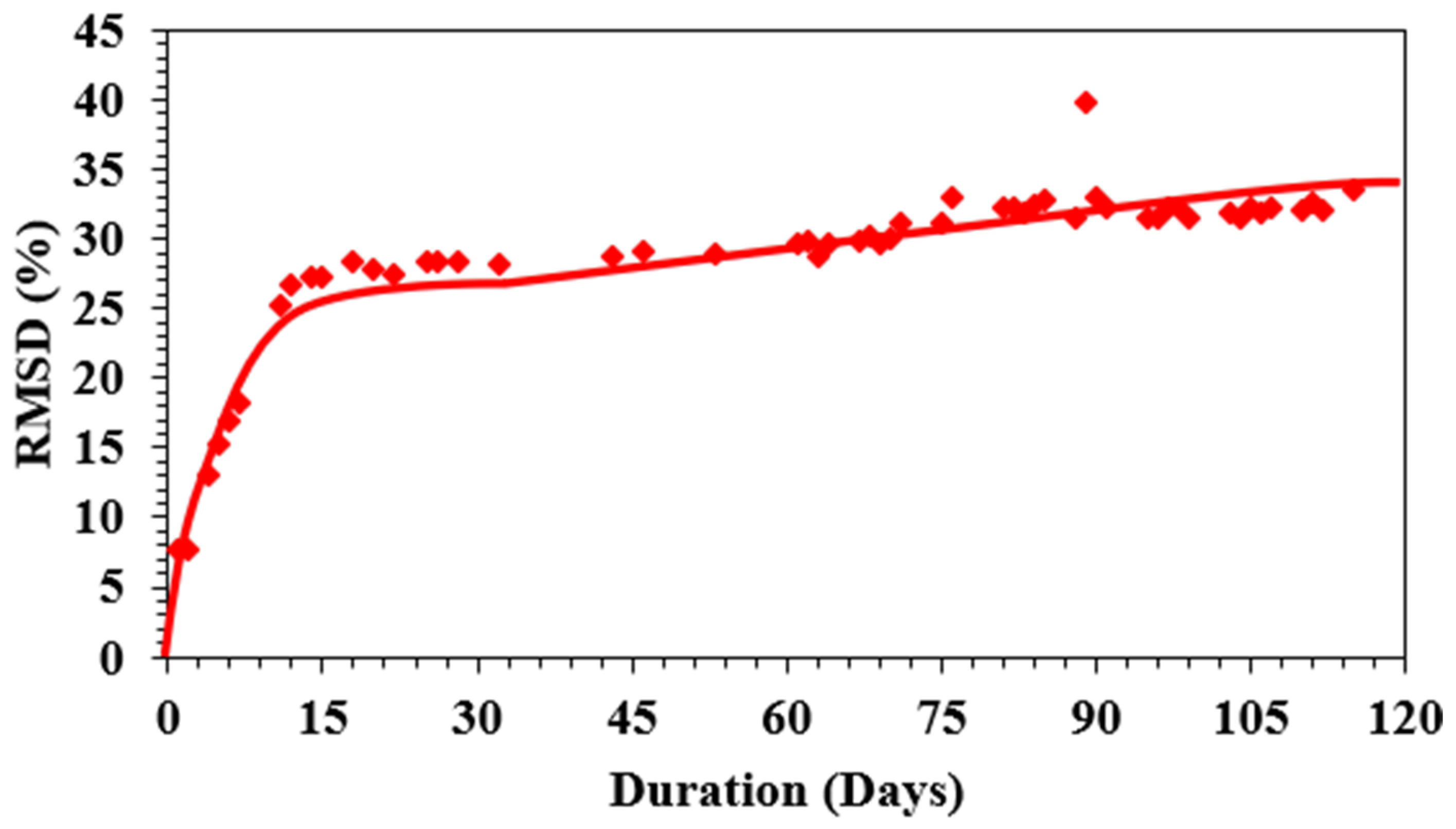
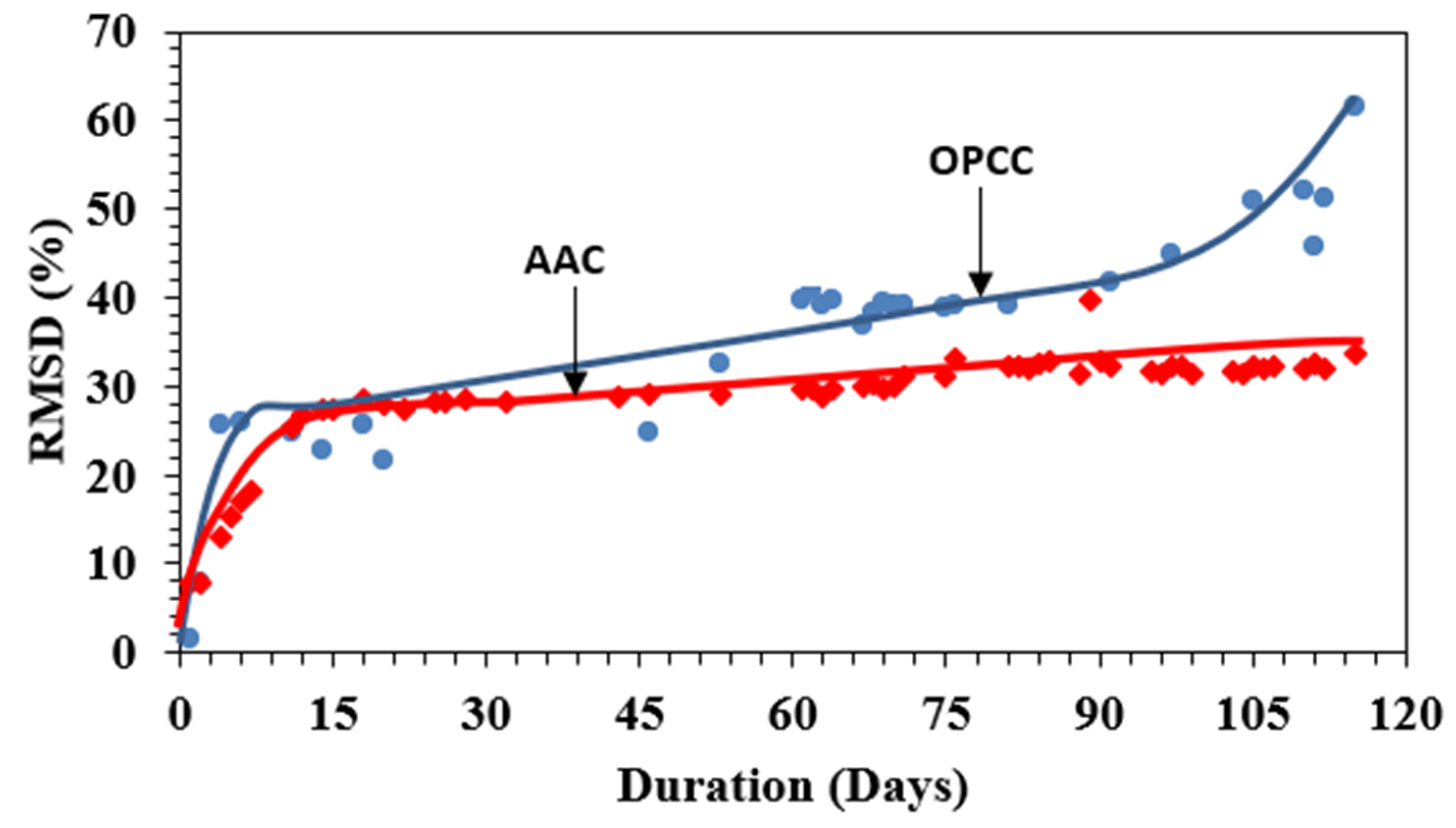

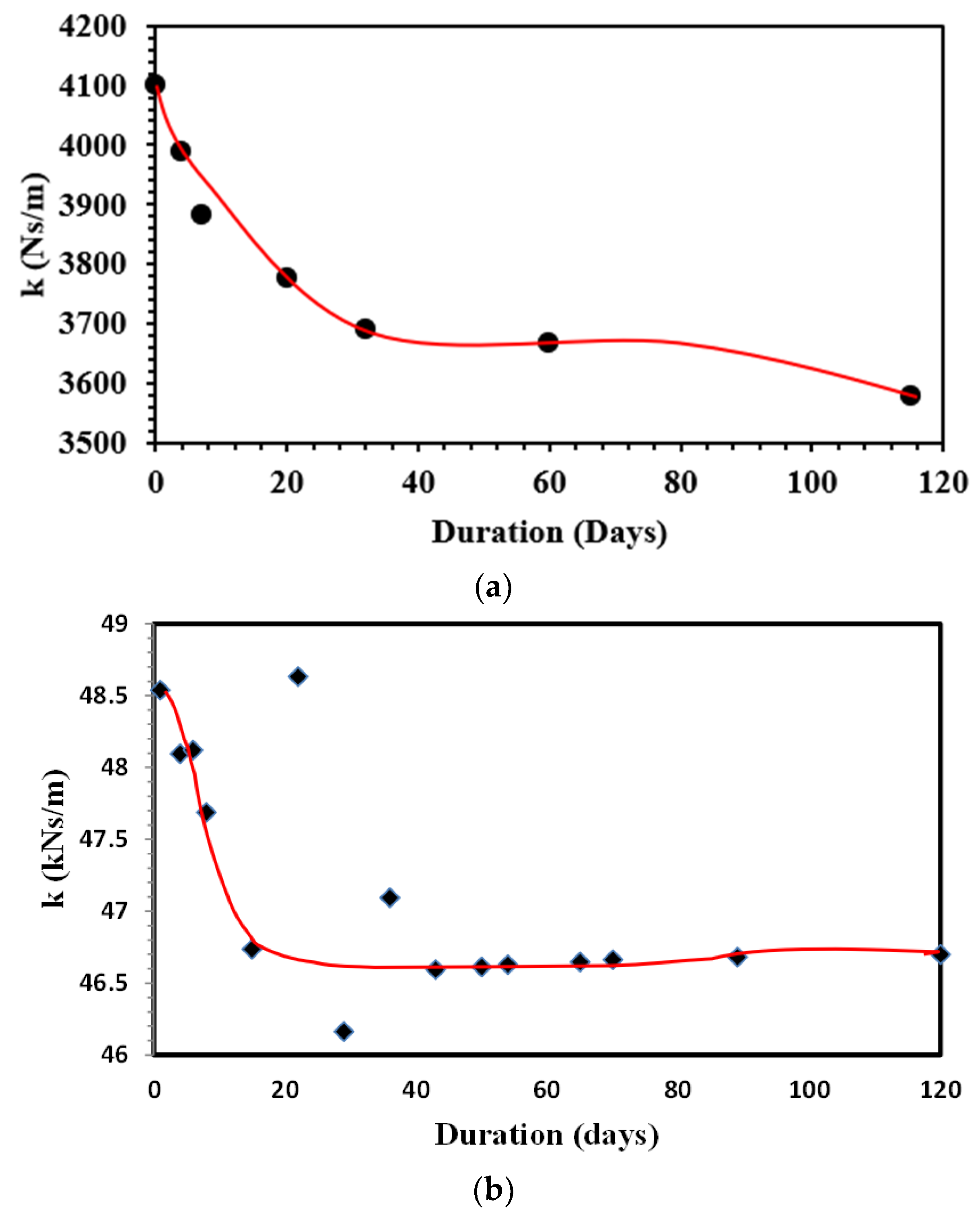
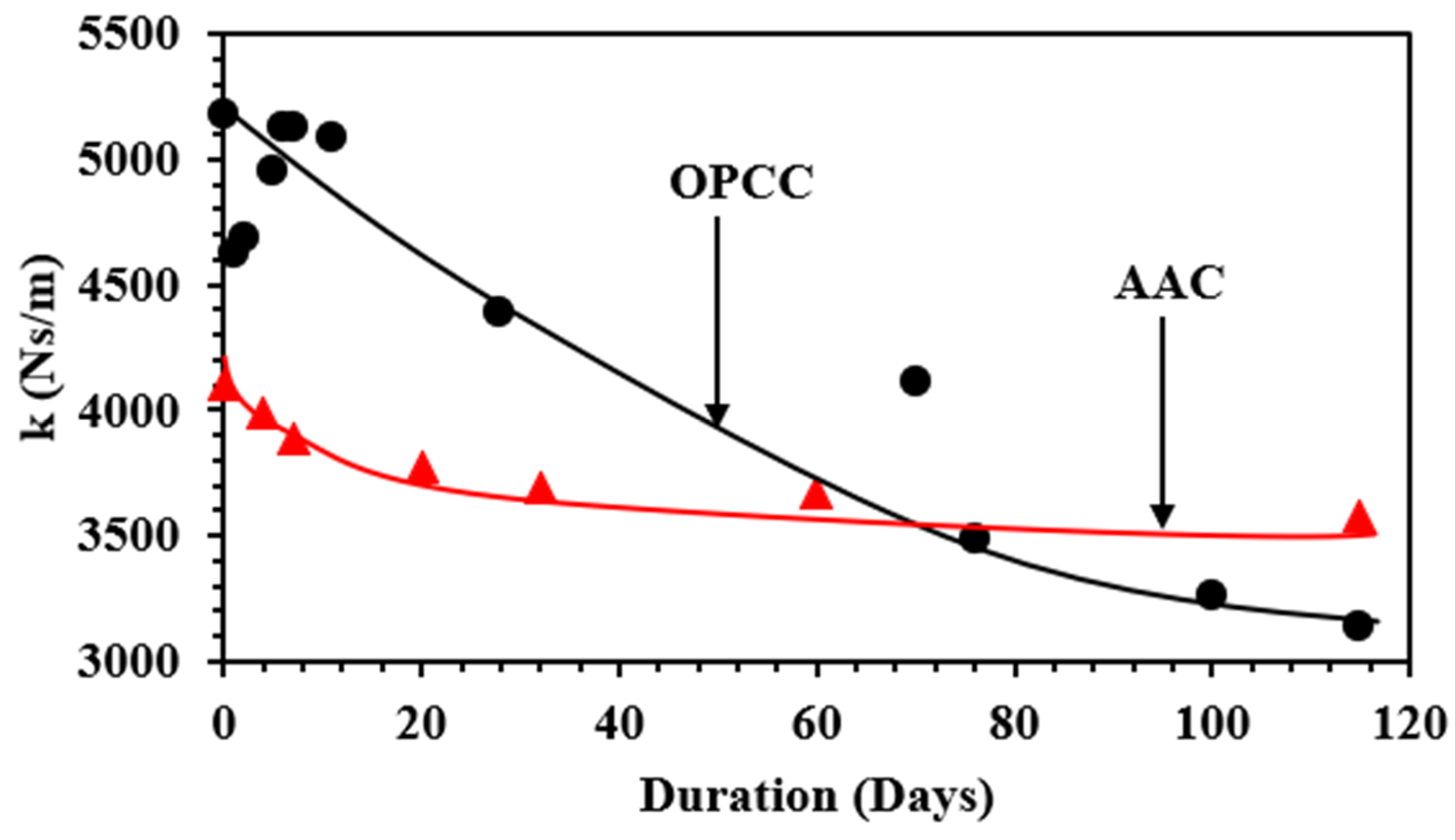
| CaO (%) | Al2O3 (%) | Fe2O3 (%) | SiO2 (%) | MgO (%) | MnO (%) | Sulfur (%) | Loss of Ignition (%) | Insoluble Residue (%) | Glass Content (%) | |
|---|---|---|---|---|---|---|---|---|---|---|
| GGBFS | 37.34 | 14.42 | 1.11 | 37.73 | 8.71 | 0.02 | 0.39 | 1.41 | 1.59 | 0.92 |
| Fly ash | 3.6 | 26.5 | 4.6 | 54.3 | 2.5 | - | - | 2.3 | 0.6 | - |
| OPC | 63.0 | 5.0 | 3.29 | 22.0 | 2.12 | - | - | 1.64 | 0.71 | - |
| Materials | OPCC | AAC |
|---|---|---|
| Water to cement ratio | 0.43 | - |
| Cement (kg/m3) | 482.55 | - |
| FA (kg/m3) | 932.33 | 500.83 |
| CA (kg/m3) | 744.38 | 876.5 |
| Water (kg/m3) | 207.5 | - |
| Superplasticizer (% by weight of cement) | 0.3 | - |
| Fly ash + GGBS (kg/m3) | - | 550 |
| Na2SiO3 (kg/m3) | - | 239.64 |
| NaOH (kg/m3) | - | 95.86 |
| Poisson’s Ratio υ | Density, ρ (kg/m3) | Dielectric Loss Factor δ | Mechanical Loss Factor (Qm) | PZT Size (Length × Width × Thickness) (mm) |
|---|---|---|---|---|
| 0.4 | 7400 | 0.02 | 70 | 10 × 10 × 0.2 |
| x | y | x vs. Freq. | y vs. Freq. | |
|---|---|---|---|---|
 |  | 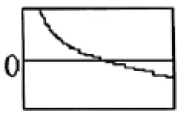 |
Publisher’s Note: MDPI stays neutral with regard to jurisdictional claims in published maps and institutional affiliations. |
© 2022 by the authors. Licensee MDPI, Basel, Switzerland. This article is an open access article distributed under the terms and conditions of the Creative Commons Attribution (CC BY) license (https://creativecommons.org/licenses/by/4.0/).
Share and Cite
Bansal, T.; Talakokula, V.; Rama Jyosyula, S.K.; Vicente, R.; Ascensão, G. Embedded Piezo-Sensor-Based Automatic Performance Monitoring of Chloride-Induced Corrosion in Alkali-Activated Concrete. Sustainability 2022, 14, 12917. https://doi.org/10.3390/su141912917
Bansal T, Talakokula V, Rama Jyosyula SK, Vicente R, Ascensão G. Embedded Piezo-Sensor-Based Automatic Performance Monitoring of Chloride-Induced Corrosion in Alkali-Activated Concrete. Sustainability. 2022; 14(19):12917. https://doi.org/10.3390/su141912917
Chicago/Turabian StyleBansal, Tushar, Visalakshi Talakokula, Sri Kalyana Rama Jyosyula, Romeu Vicente, and Guilherme Ascensão. 2022. "Embedded Piezo-Sensor-Based Automatic Performance Monitoring of Chloride-Induced Corrosion in Alkali-Activated Concrete" Sustainability 14, no. 19: 12917. https://doi.org/10.3390/su141912917







